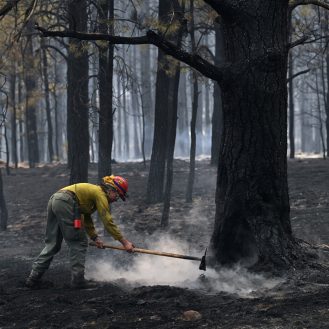If the new United Nations loss and damage fund lives up to the promise of its first full board meeting, it could be a game-changer for climate finance by speeding relief money to areas hit by fossil-fueled global warming disasters like floods, heatwaves and droughts.
“The loss and damage fund can be truly transformational,” said Lien Vandamme, a policy expert with the Center for International Environmental Law who attended the fund’s first board meeting in Abu Dhabi last week as an observer.
She saw hopeful signs at the meeting that the fund will use a more inclusive and participatory decision-making process to give countries hit by climate disasters more direct access to money for rebuilding, steering climate finance in a new direction.
“Developing countries have been clear from the start that this fund needs to be different,” she said. “It can no longer be about consultants flying in and out of a country to implement a project. The fund should contribute to strengthening the capacity of countries vulnerable to the climate crisis to deliver the support needed to their communities.”
Loss and damage is the United Nations climate bureaucracy’s term for funds and funding mechanisms designed to quickly and directly help communities cover the costs of lives, livelihoods, property and infrastructure lost to climate disasters without driving them deeper into debt.
The concept is embedded in the United Nations Framework Convention on Climate Change’s (UNFCCC) founding language as a principle of fairness that rich and developed countries—which produced the vast majority of the cumulative greenhouse gas emissions driving global warming—will help developing countries that have done little to heat the climate but are enduring disproportionate damages from extreme weather events and other climate impacts.
After simmering as a side issue for 20 years, loss and damage became a central pillar as Article 8 of the 2015 Paris Agreement. The 196 UNFCCC countries agreed in 2022 at COP27 in Egypt to establish the fund, and a year later, at COP28 in Dubai, the preliminary plan was approved, leading to the formation of the board that met last week.
The World Bank Will Host The Loss and Damage Fund
The board of the loss and damage fund has 12 members from developed countries and 14 from developing countries, distributed both geographically and among the United Nations development levels. So far, 19 countries have pledged a total of $661 billion to the fund. No specific goal for a total sum in the fund has been identified but developing countries said during the formation process that it should be able to pay out $100 billion per year from the start.
The fund will be hosted, at least temporarily, by the World Bank, despite some developing countries suspicions of the institution due to its history of being part of the problem of climate change rather than the solution. Other concerns about the World Bank hosting the loss and damage fund include high financial fees and a perception that it is controlled by large donors, according to an analysis by Climate Analytics, an international climate policy think tank.
As a result, the hosting agreement with the World Bank is subject to a list of conditions originally spelled out in the COP27 loss and damage decision text, and formal approval is still pending. Key conditions include independence for the loss and damage fund board to choose an executive director and to establish its own eligibility requirements, as well as ensuring that developing countries, including countries that are not members of the World Bank, can directly access resources.
But after recent reforms, the bank is set to accept the conditions and to engage with the fund’s board to make them work, said Renaud Seligmann, the World Bank’s director for strategy and operations with the sustainable development practice group.
In April, the World Bank’s board of directors gave a “resounding vote of support for the bank’s role as interim trustee and interim host of this fund,” he said.
Still outstanding, he said, is “a finalized model” that is consistent with all existing UNFCCC decisions on loss and damage and is consistent with “the principles of good governance and good risk management that are embedded in our policies.”
Seligmann said the bank is confident that it can meet a June 13 deadline to meet the conditions of the UNFCCC for the fund.

Based on the progress made in the relationship with the World Bank during last week’s board meeting, the fund should be finalized by the end of the year at the latest, said Harjeet Singh, an observer with the global Fossil Fuel Non-Proliferation Treaty Initiative who previously worked on loss and damage with Climate Action Network International, a globe-spanning civil society group.
Singh said that, to him, the process of establishing the loss and damage fund, especially the last few years, has felt more collaborative than some other UNFCCC processes, possibly because it’s almost impossible to ignore the dire costs of climate impacts adding up globally.
“This journey … has been very different,” he said. The process has been more inclusive for civil society from the start, leading to a “very different space where everyone feels like they are building a ship together,” he said.
For Singh, one of the key conditions in the agreement with the World Bank is that loss and damage funds become directly available to countries and communities as grants, and not as loans through third-party financial intermediaries. The signals from the bank on that condition are positive, he said.
“There is no cut that goes to the intermediary organization for their own overhead,” he said. “And there are no strings attached on how money needs to be spent, so money moves much faster.”
When a disaster strikes, he said, countries that need help should be able to send a simple one or two page proposal, without first doing a massive damage assessment, and the loss and damage funds should flow right away, because delays do nothing but “push these countries back by several years or decades, and deeper into a debt cycle,” he said.
A Trillion Dollar Question
Research estimates current loss and damage costs in developing countries at between $290 and $580 billion per year, which will up to between $1 trillion to $1.8 trillion by 2050. Singh said the board of the Loss and Damage Fund should be thinking on that order of magnitude.
“If you don’t have a vision of a trillion dollar fund, if you create a fund which is just channeling a couple of millions, sorry, it’s a disrespectful waste of time,” he said.
Setting an overall finance goal and identifying sources should be part of the board’s next meeting, “where things are going to get a lot more challenging,” he added.
But there are opportunities for climate finance in the global economy, especially looking beyond legislative appropriations from national entities, he said. Redirecting fossil fuel subsidies, for starters, would be one of the simplest and most logical steps to could raise billions quickly, he said.
At COP28, Barbados Prime Minister Mia Mottley outlined a series of finance measures that could address the urgent needs of developing countries without disrupting economies.
“If you don’t have a vision of a trillion dollar fund, if you create a fund which is just channeling a couple of millions, sorry, it’s a disrespectful waste of time.”
As examples, she cited a 0.1 percent global financial services tax that could raise $420 billion and a 5 percent tax on last year’s $4 trillion in fossil fuel profits that would raise $200 billion.
“They wouldn’t lose anything or feel that they lost anything and they would still be able to function and to expand,” she said. “Thirdly, if we had a 1 percent tax on the value of shipping, $7 trillion last year, that would give us $70 billion.”
But there is no governance framework to create such financial mechanisms.
“Who is going to enforce it,” she said. “We have to reach a global compact that allows countries to recognize that they cannot only act in their own deliberate interest, but they have to also act in the interest of the preservation of global public goods.”
Will the United States Contribute?
France, Germany, Italy and the United Arab Emirates have all pledged at least $100 million to the fund. The United States was criticized at COP28 for a relatively small $17.5 million pledge, but former U.S. Special Climate Envoy John Kerry has said that talking about damages pushes people away, and that the world will “never see a dime” from the U.S. for anything that sounds like an admission of liability or smacks of compensation.
The U.S. has been very clear that it does not see loss and damage finance as reparations or having any link to compensation or liability, which might leave a way to thread that political needle, said Brandon Wu, who was at last week’s loss and damage fund board meeting as an observer with Action Aid USA. Still, he said it’s doubtful that Congress will ever approve loss and damage funding.
This story is funded by readers like you.
Our nonprofit newsroom provides award-winning climate coverage free of charge and advertising. We rely on donations from readers like you to keep going. Please donate now to support our work.
“Given that we did not get any money appropriated for the more established Green Climate Fund under the Biden administration’s first two years with Democratic control of both houses of Congress, this does seem rather challenging,” he said. “However, Biden’s budget request has included the GCF for the past couple of years.”
That climate funding was not approved by Congress, but a big win for Democrats in November could change the equation, he added.
“One would have to think that in the case of a second term and Democratic control of Congress, they will be willing to be much bolder on climate action of all sorts,” he said. “It’s becoming clearer and clearer that supporting communities to address loss and damage from climate impacts has to be a core part of the global climate response.”









